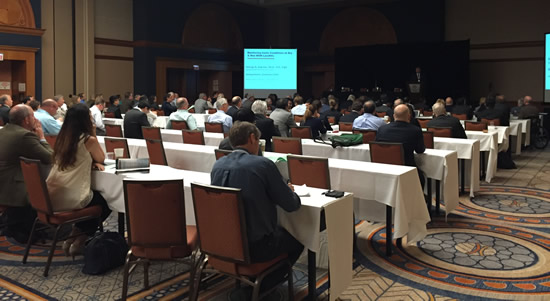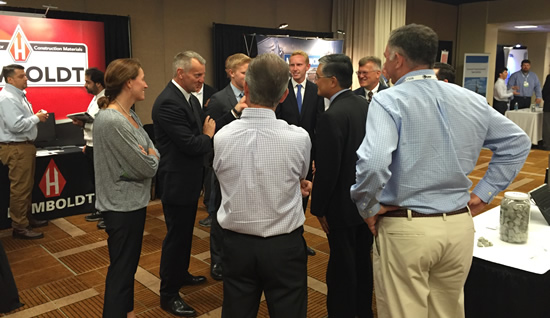



Geosynthetics were a prominent part of ASCE Geo-Institute‘s GeoChicago 2016 conference, which was held August 14 – 18 at the Sheraton Grand in downtown Chicago. The riverfront location, just off Lake Michigan, gave attendees a vibrant urban area for social events and, with the substantial ongoing river walk, greenspace, and bridge network redevelopment, more than ample opportunity for observing geotechnical works firsthand.
Program co-chairs Dr. Krishna R. Reddy, P.E., D.GE, F.ASCE (University of Illinois at Chicago) and Dr. Nazli Yesiller, A.M.ASCE (Global Waste Research Institute) designed a program that made this edition of the conference one of the most successful Geo-Institute shows in years. The 550 attendees represented 32 countries. Dr. Reddy noted in his opening remarks that the early activity was reminiscent of “the old days” in geotechnical conferences.
GEOSYNTHETICS LEAD THE WAY
The substantial geosynthetics content may have helped drive the strong attendance growth at GeoChicago 2016. Two special symposia honored Dr. Robert Koerner and Dr. David Daniel. Addtionally, Dr. Nathalie Touze-Foltz (IRSTEA) and Dr. Tim Bauters (Golder Associates) moderated a standing-room only session on “Advances in Design, Testing, and Evaluation of Geosynthetics Used for Geoenvironmental Systems.”
Each symposium drew 100+ attendees, while the “Advances in Design…” had roughly 100 observers (in a room with ~80 seats).
Geosynthetic clay liners (GCLs), in fact, were strongly incorporated throughout the conference. Beyond their inclusion in the symposia, Dr. Craig Benson delivered a keynote on sustainability in geotechnics that included GCL details; Dr. Mario Manassero delivered a keynote on bentonite barriers; the Touze-Foltz/Bauters-moderated session had multiple GCL entries; and various technical sessions incorporated GCLs on topics such as interface transmissivity and hydraulic conductivity and solute transport. Their use in remediation projects and environmental protection were highlighted.
For the past decade, geosynthetic clay liners have been at the center of significant innovations. Manufacturing advances to the external structure of a GCL and bentonite modifications have expanded the engineering roles for this barrier solution. These advances have also prompted plenty of attention at conferences.
In 2010, Germany-based SKZ, France-based Irstea (then known as Cemagref), and the US-based Geosynthetic Institute (GSI) organized the 3rd International Symposium on Geosynthetic Clay Liners. Held in Würzburg, Germany, the event raised discussions on durability, performance (e.g., cation exchange, desiccation), testing, and GCL utilization in major applications.
Two years later, ASTM International Committee D35 held a special symposium: The Third Symposium on Current and Future Practices for the Testing of Multi-Component Geosynthetic Clay Liners. That gathering, which took place during ASTM’s June Committee Week in San Diego, placed a more intense focus on the quickly expanding varieties of GCLs. These varieties included engineered coatings, modified bentonite, film attachments, and other components that have enhanced GCL performance.
Together, these events underscored two main points:
- The use and acceptance of GCLs in engineering has broadened substantially
- Manufacturing and design advances have enabled GCLs to be far more application- and site-specific now
Now, we see conferences such as GeoChicago 2016 highlighting not just theoretical justifications but practical, every day examples of GCL advantages in civil engineering.
GEOCHICAGO 2016 HIGHLIGHTS
Dr. Robert Gilbert spoke during the symposium to honor Dr. David Daniel and delivered a ringing quote: “One of Dave Daniel’s gifts to has been to explain complex engineering issues in simpler terms.”
That also effectively sums up one of the leading characteristics of the geosynthetics field over the past 30 years: a focus on making geotechnical engineering accessible. Bob Koerner has certainly contributed that approach to the field as well. Like Dave Daniel, Koerner has conducted high-level research and reported it on varying levels, from refereed academic journals to practical lectures to simple columns in field publications. The range of communication strategies utilized by these two pioneers have helped deliver geosynthetics and affiliated geotechnical information to all levels of stakeholders in engineering projects.
Dr. Craig Benson added another comment that underscores the geosynthetics field’s work: “Being quantitative is essential.”
From raw material selection to manufacturing quality control to installation practices and long-term monitoring, geosynthetics are driven by data—data which results in practical, economical, sustainable solutions.
Perhaps the most intriguing moment on geosynthetics came in remarks from Bob Koerner, who noted that 35 years ago, when his deeper investigations into geosynthetics began, he made two assumptions:
- Geosynthetics would have short service lives
- Geosynthetics were easy to install
Today, he noted, he believes—and has quantitative evidence!—of the exact opposite. The research indicates 100s of years of service lives in certain designs; and installation is a process that requires experience and care and ultimately has a tremendous impact on the success of a project.
For more information about ASCE Geo-Institute events, visit www.geoinstitute.org/g-i-conferences.











